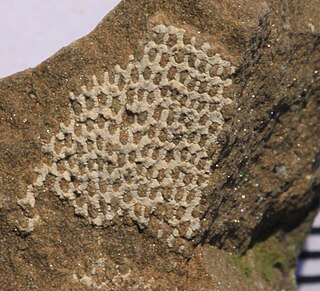 W
WCyrtospiriferidae is an extinct family of Brachiopods.
 W
WFenestellidae is a family of Bryozoans belonging to the order Fenestrida. The skeleton of its colonies consists of stiff branches that are interconnected by narrower crossbars. The individuals of the colony inhabit one side of the branches in two parallel rows or two at the branch base and three or more rows further up. Zooids can be recognized as small rimmed pores, and in well-preserved specimens the apertures are closed by centrally perforated lids. The front of the branches carries small nodes in a row or zigzag line between the apertures. Branches split from time to time giving the colonies a fan-shape or, in the genus Archimedes, create an mesh in the shape of an Archimedes screw.
 W
WHeterotrypidae is an extinct bryozoan family in the order Trepostomata.
 W
WThe Luolishaniidae or Luolishaniida are a group of lobopodians with setiferous forelimbs known from the Cambrian period. The presence of thorn-shaped sclerites arranged as three per segment is diagnostic. The type genus is based on Luolishania longicruris Hou and Chen, 1989, from the Chengjiang Lagerstatte, South China. They are presumed to have been filter feeders. New specimens of the previously engimatic Facivermis show that it was a sessile tube-dweller, and part of this group.
 W
WPlaesiomyidae is a family of extinct lamp shells belonging to the order Orthida.
 W
WPrionorhynchiidae is an extinct family of brachiopods belonging to the order Rhynchonellida.
 W
WPygopidae is an extinct family of Brachiopods.
 W
WTerebratellidae is an extant family of brachiopods with a fossil record dating back to the Jurassic.
 W
WTerebratulidae is a family of brachiopods with a fossil record dating back to the Late Devonian. It is subdivided into 11 subfamilies.
 W
WTrigonotretidae is an extinct family of articulate brachiopods belonging to the order Spiriferida.
 W
WUncitidae is an extinct family of brachiopods.